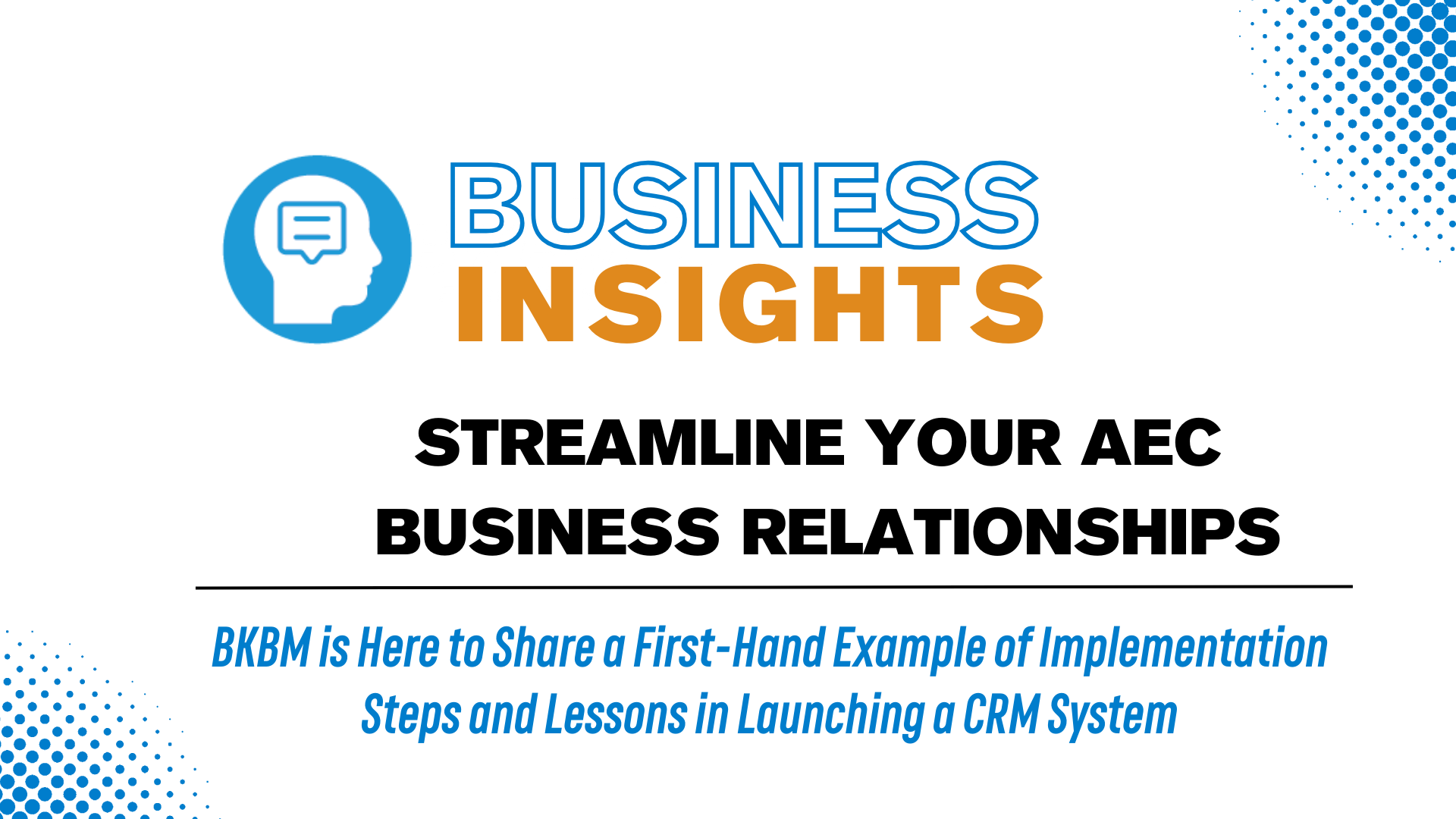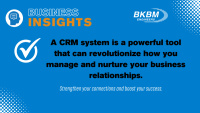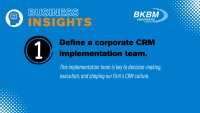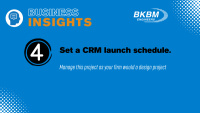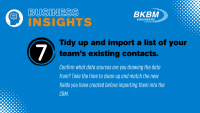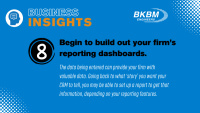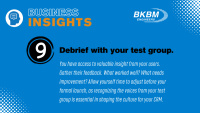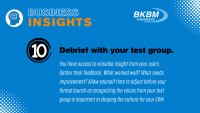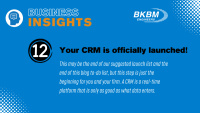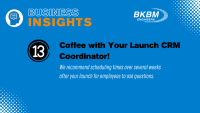BKBM is Here to Share a First-Hand Example of Implementation Steps and Lessons in Launching a CRM System
BKBM, an established civil and structural engineering firm with offices in Minneapolis and Denver, recently integrated a formalized CRM (Customer Relationship Management) system into its operations. At BKBM, building and nurturing lasting relationships is one of our core values ingrained in our brand philosophy. We realized the need for a tool to manage existing client relationships and effectively support our growth strategy, so we implemented a formal CRM. This choice was driven by the daunting challenge of figuring out how to gather the essential information needed to track our strategic goals. Our past data came in all forms - from various legacy marketers looking to retire to many sources within the company, such as our business cards, Outlook contacts, Excel spreadsheets, project folders, and even handwritten notes (perhaps something your firm can relate to)!
In this blog article, we will walk you through our approach to CRM implementation and share valuable insights that can help our industry peers successfully adopt a CRM in their AEC firms.
What is a CRM, and How Can It Provide Opportunities for Your Design or Construction Firm?
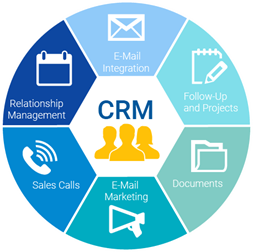 A CRM system is a powerful tool that can revolutionize how you manage and nurture your business relationships. It is a technology solution that enables you to gather, organize, and analyze data about your clients and partners in one centralized platform.
A CRM system is a powerful tool that can revolutionize how you manage and nurture your business relationships. It is a technology solution that enables you to gather, organize, and analyze data about your clients and partners in one centralized platform.
But what makes a CRM system so valuable? Well, it's all about the data-driven approach it provides. With a CRM system, you can collect valuable insights about your active opportunities, client communication and event engagement, and digital interaction. This data can help you better understand your clients and tailor your solutions and strategies accordingly. By leveraging these insights, you can enhance client satisfaction, foster stronger relationships, and drive business growth.
In addition, a CRM system can help improve collaboration and communication within your organization and can help foster a seller-doer culture. It can promote an organizational shift in culture to support transparency, collaboration, and accountability. With a centralized platform, all teams within your organization could share valuable connections, show progress on relationships, introduce opportunities, and track meaningful touch points with clients. Everyone can access and share important client information, ensuring everyone is on the same page. This promotes collaboration and helps to avoid duplicate efforts or miscommunications.
In today's fast-paced business climate, having a CRM is essential. With limited resources for in-person business development, this robust platform offers complete transparency into client activities, enabling teams to strategize and execute their plans efficiently from the comfort of their computers.
BKBM’s Approach to Implementing a CRM
BKBM knew that successfully implementing a CRM required careful planning. Benjamin Franklin's words, “If you fail to plan, you are planning to fail,” provided the mindset necessary for a successful launch. BKBM laid out the following plan for a CRM launch:
- Define a corporate CRM implementation team. At BKBM, representatives from marketing, business development, IT, and leadership were on the implementation team. This implementation team was the key to decision-making, execution, and shaping our firm’s CRM culture.
- Define goals and evaluate and test the various platforms available. Sign up for free test versions if necessary. You are going to live and breathe in this platform; you must be comfortable functioning in it every day. Three guiding goals were defined as we set to evaluate CRM platforms, including Organize and nurturing leads, increasing accountability, productivity, and efficiency, and get visibility.
Within these overarching goals, specific features that guided our platform selection was the efficiency of use for our team with having an automated sync with Outlook. Additional priorities included the ability to easily customize the data collection in-house (build out our records), the number of users allowed, the up-front and ongoing cost, and integration into marketing platforms. A comparison between four platforms was performed prior to selecting the platform we would implement.
- Equally crucial to the launch of the system is the development of a CRM-driven culture. The firm's business development and marketing departments need to work in tandem with its leadership to convey the platform's value to the broader user group. This requires a comprehensive educational component to ensure that everyone understands the system's functionality. This message needs to be communicated to the company from various levels and communication channels.
- Set a CRM launch schedule. A CRM launch is a significant project for a firm, and these deadlines should be taken seriously. Educating and communicating the milestones with leadership along the way is valuable. Manage this project as your firm would a design project. Click here for a sample schedule (dates are dates used by the BKBM team).
- It is important to confirm early in the process what data you want to collect. What story do you want this CRM to tell about your client relationships? What data is going to be most valuable to your firm and employees? These decisions may help select which platform will work best for you. You will also tailor your records so confirm from the outset the information you want each record to collect to avoid adjusting once the information begins to pour in.
- To work out the kinks and get used to using the CRM, put together a test group to trial the system. At BKBM, this test group included a representative mix of employees at all levels within the company and the trial period lasted 8 weeks. All this testing was led by the CRM Launch Team, who provided technical assistance and helped ensure that the system was able to integrate with the company's existing emails properly. This was a great opportunity to work with IT to work through all infrastructure integration issues. Depending on your firm size, you may bring IT into the mix sooner or later.
- As your test group is settling into the platform, your launch leader or coordinator must oversee tidying up an import list of your team’s existing contacts. Confirm what data sources are you drawing the data from? We strongly suggest that you carefully monitor the quality of the information going in to receive the best results. Take the time to clean up and match the new fields you have created before importing them into the CRM. BKBM did this using a company Master Excel document since it was far simpler than attempting it in the CRM once everything was merged.
- While your test group users are actively entering data, look at your CRM’s reporting features. The data being entered can provide your firm with valuable data. Going back to what ‘story’ you want your CRM to tell, you may be able to set up a report to get that information, depending on your reporting features.
- Debrief with your test group. You have access to valuable insight from your users. Gather their feedback. What worked well? What needs improvement? Allow yourself time to adjust before your formal launch as recognizing the voices from your test group is important in shaping the culture for your CRM. This is also a great opportunity to set the tone with your team and drive that first push for a collaborative and transparent culture for our client relationships. The test group will be able to showcase how valuable it is to share information on our past projects, opportunities, and connections.
- As you are approaching your launch, make sure to keep the communication active. You must communicate the process and value of the implementation effectively. The process should be coming from more than just the marketing/sales team. Make sure that leadership is also sending messages as well.
- Provide training for using the platform. BKBM chose to do a small group lunch and learns led by the Marketing Director. This was to support conversations and Q&As. Being that the CRM was new to most of our team members, the approachability provided with small group meetings was key
- Your CRM is officially launched! This may be the end of our suggested launch list and the end of this blog to-do list, but this step is just the beginning for you and your firm. A CRM is a real-time platform that is only as good as what data enters. For those who are empowered with knowledge, if your CRM is set up to this point, you will be with great data to shape strategy for your firm.
- Coffee with Your CRM Launch Coordinator. We recommend setting up scheduled times over the course of several weeks after your launch for employees to ask questions. BKBM hosted coffee with our Marketing Director weekly after our launch. It was an open-door, drop-in forum to ask questions. We learned that bugs would occur within the platform and new processes require repetition to learn. Be available for your team to help coach them on the CRM and its utility and value. This is when process and open communication will really shine, helping to bring other team members up to speed quickly.
Best Practices for Maximizing the Potential of Your CRM Tool
Using a CRM system can significantly benefit your business and streamline your relationships with clients and partners. Here are some tips to help you successfully use a CRM system in your own business:
- Take the time to properly set up and customize your CRM system to fit your unique needs. This includes inputting relevant data, creating customized workflows, and integrating the system with your existing tools and software.
- Ensure that all employees are appropriately trained to use the CRM system. This will empower them to take full advantage of its features and functionalities, ultimately leading to greater efficiency and productivity.
- Regularly update and maintain your CRM system to ensure the data remains accurate and relevant—schedule routine data cleansing and validation processes to eliminate duplicates or outdated information.
- Leverage the power of data analytics and reporting within your CRM system. Use these insights to identify trends, spot opportunities, and make informed decisions that drive your business forward.
- Foster a culture of collaboration and communication within your team. Encourage everyone to regularly input and update information in the CRM system, as this will ensure everyone is on the same page and can provide seamless client experiences.
By following these best practices, you can make the most out of your CRM system and effectively manage your business relationships for long-term success.
BKBM Is Here as an AEC CRM Resource
Ultimately, BKBM's story can be a roadmap for other AEC firms investing in a CRM system. With the right planning and education, such a system can become a powerful asset to help organizations maintain and develop their relationships. If you have any questions, please contact BKBM's Marketing Director Catie Wheeler. We would be happy to be a resource with any questions.
Overall, BKBM’s selected CRM platform has been a powerful tool for fostering organizational transparency and collaboration. Giving us a 360-degree view of our business relationships and integrating them with our existing tools has empowered us to work together more efficiently and effectively.


